A good enterprise SEO audit is like gold for businesses.
Over the years, I’ve teamed up with countless top-tier companies and discovered what truly makes SEO click. I’ve had my highs, my lows, and in between and gathered a mountain of real-world wisdom on how to perform a result-driven enterprise SEO audit.
Now, think about having all that know-how squeezed into one easy-to-read guide. Sounds handy, right?
Well, that’s what I curated in this post. Dive in and discover my little hacks and shortcuts to nail that SEO audit game. Welcome to your cheat sheet for top-notch enterprise SEO audits. Let’s get started.
What Is An Enterprise SEO Audit?
An enterprise SEO audit is a comprehensive evaluation of your website’s SEO performance. It gives you a detailed roadmap that highlights the areas where your website can shine.
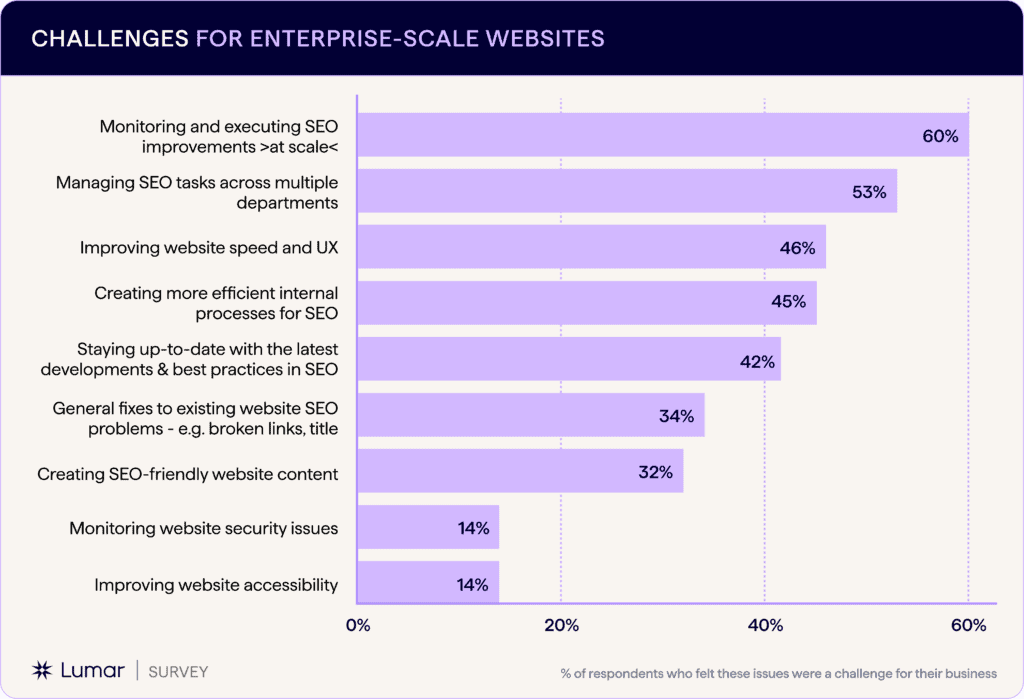
More pages mean more potential for issues. It’s easy for things to slip through the cracks, leaving potential untapped and hurting your search rankings.
At the end of the day, it’s all about making your web pages more attractive to bots and crawlers to help them understand your site better and boost your rank in search engine results pages (SERPs).
Conducting an enterprise SEO audit helps you uncover hidden opportunities, fix technical glitches, and craft compelling content that resonates with your target audience.
As a case in point, one of our clients, Estuary, had difficulties reaching their target audience since they lack visibility, getting just 12 site visitors daily.
We started auditing their enterprise site, primarily their content to identify gaps and determine where and what to improve.
We did a competitor gap analysis and search term deconstruction. Eventually, we increased Estuary’s organic search traffic by 2,407% in just 6 months.
But is enterprise-focused SEO really necessary? Won’t regular SEO cut it? Let’s consider the answers.
5 Key Differences: Enterprise SEO Audit vs Regular SEO Audit
| Factors | Enterprise SEO Audit | Regular SEO Audit |
| Scope & Scale | For complex, large websites with thousands of web pages. | For smaller websites with at least 10 to 30 pages and have simpler site structures. |
| Search Term Strategy | Uses high-level keyword research, going for broader search terms that pull in massive organic traffic. | Targets long-tail, niche search terms to bring in relevant traffic. |
| Technical Challenges | Tackle intricate technical issues, such as site speed, crawlability, and indexation of a vast website. | Deal with relatively fewer technical complexities and focus on specific page-level optimizations. |
| Stakeholders | Involves multiple stakeholders – from marketing to IT. | 1 person or a small team can handle the decision-making process. |
| Budget | Requires a larger budget, allowing for robust strategies and tools to manage large-scale optimization. | Smaller budgets can suffice, focusing on cost-effective tactics. |
Knowing the key differences between enterprise SEO and regular SEO is like choosing the right tools for a job. You wouldn’t use a sledgehammer to hang a picture, right?
Similarly, having a grasp of these differences lets you choose appropriate SEO tools, decide when to conduct an SEO audit, and allocate your resources appropriately.
Equipped with insights on what sets enterprise SEO apart, let’s roll up our sleeves and dig into the real stuff. Let’s dive headfirst into our comprehensive audit checklist.
How To Perform An Enterprise SEO Audit: 27-Point Checklist
With thousands of pages to manage, it’s easy to get lost in the maze. To guide you toward a successful SEO strategy and avoid wasting resources, we’ve developed a 27-point checklist.
We divided it into 5 categories: On-page, off-page, technical, user experience, and industry so it’s more digestible. Let’s start!
On-Page Enterprise SEO Audit Points
On-page SEO is about creating and optimizing compelling content for target search terms. Think of well-crafted meta descriptions to hook users, headers that guide their journey, and engaging content that answers their queries.
1. Which search terms should I target?
Find the sweet spot – search terms relevant to your business with high search volume (1,000 to 10,000+) and manageable keyword difficulty (30% to 50%). Analyze your content and make sure it matches the searcher’s intent.
Develop a topical map that includes all topics and entities relevant to your site. Then, create tiers for each topic based on their importance – this is your topical hierarchy. It helps cover each topic holistically, building your site’s topical authority.
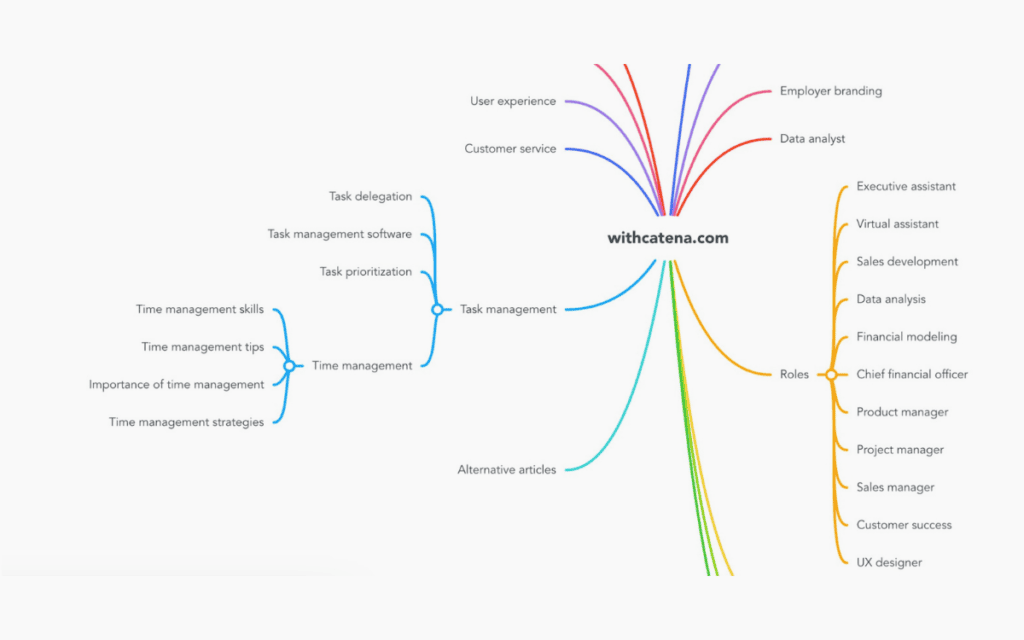
Leverage the SEO data of existing competitors using tools like SEMrush. Each tool works differently so once you’ve chosen yours, take the time to study it so you can maximize its features for competitor analysis. In most cases, you just have to provide the competitor site link.
Once you have your topical map, it’s time to dig deep into search term deconstruction. Here’s where you map out relevant search terms based on your topics and hubs. Use tools like Ahrefs, Google Keyword Planner, and Google Trends.
2. Are my URLs user-friendly?
URLs are mini billboards for your web page content. Clear, straightforward URLs give both users and search engines a quick hint of what’s on the page.
For instance, find the difference between these two: “www.yourwebsite.com/123456” and “www.yourwebsite.com/seo-audit-guide”
Notice the difference? The second URL includes the target search term and reflects the content.
To help you further, Google has a list of the do’s and don’t when it comes to URL structuring.
3. Did I optimize meta tags properly?
Meta tags act as your website’s calling cards as they give users a snippet of what each page is all about. So, how can you make sure they’re optimized?

First, your title tags and meta descriptions should front-load your primary search term and other relevant search terms.
For example, if your topic is about organic coffee beans, the title and meta description could be like this:
- Title: Best Organic Coffee Beans For A Fresh Morning Brew
- Meta description: ‘Explore our range of carefully sourced organic coffee beans for that perfect morning cup. Try the best organic coffee today!
Sprinkling the target search term “organic coffee beans” in your meta tags will ramp up your site visits as it tempts users to click your page to get a preview of the content. This clever little tweak can turbocharge your SEO outcomes.
The ideal length for meta descriptions isn’t set in stone, but it’s advisable to limit them to 165 characters. This is the usual count so all the words are displayed on Google’s SERP. But once in a while, have a sentence cut off to create a sense of suspense or an “information gap.” Users are naturally inclined to seek closure or completeness.
4. Is my content high-quality & in-depth?
At the heart of on-page SEO, quality content reigns supreme as a Google ranking factor. Your SEO efforts should focus on creating content that’s not just informative, but captivating and worth sharing.
Avoid keyword stuffing. Instead, optimize naturally for search engine indexing.
So, how do you do this?
Maximize the hub and spoke method. The hub is your main subject and is typically a broad, high-volume search term that you want to rank for. The spokes are long-tail or secondary search terms that are more specific and related to the main search term.
Here’s an example:

For our yard management service client, one of the hub search terms we leveraged is “inventory management” and the spoke search terms associated with it are “ jit logistics” and “supply chain visibility.” Each spoke represents a piece of content that focuses on those more specific terms, but also links back to the hub search term.
Targeting long-tail search terms in the spokes lets you rank for more specific, less competitive search queries, while also supporting the authority of your hub content. This reinforces the topical connections to search engines, making your site more comprehensive and authoritative on the subject.
5. Which web pages should I link internally?
Linking to landing pages and blog posts signals search engines that these pages are important and that they deserve higher visibility.
These internal links act as roadmap markers guiding Google’s crawlers through your website. Internal linking establishes a clear website hierarchy, helping search engines understand and index your content landscape.
Here are techniques to help your internal linking structure:
- Descriptive anchor text: Instead of generic phrases like “click here,” use descriptive anchor texts. This hints to search engines about the linked page’s topic and improves user experience.
- Content hubs and spokes: Create a central hub page (a comprehensive guide on a topic) and build related spoke pages (subtopics). Link these back to your hub to boost authority and relevance.
Moreover, a well-implemented internal linking structure disperses “link juice,” or authority, throughout your site. This bolsters the strength of lesser-known pages and helps to improve your overall site architecture.
6. Are relevant external links a must?
Sure, external links might guide readers off your site, but they play a role in improving your enterprise website’s credibility and user experience.
Think about it: you’re offering your readers additional resources to deepen their understanding – it’s like telling the readers that you prioritize their welfare.
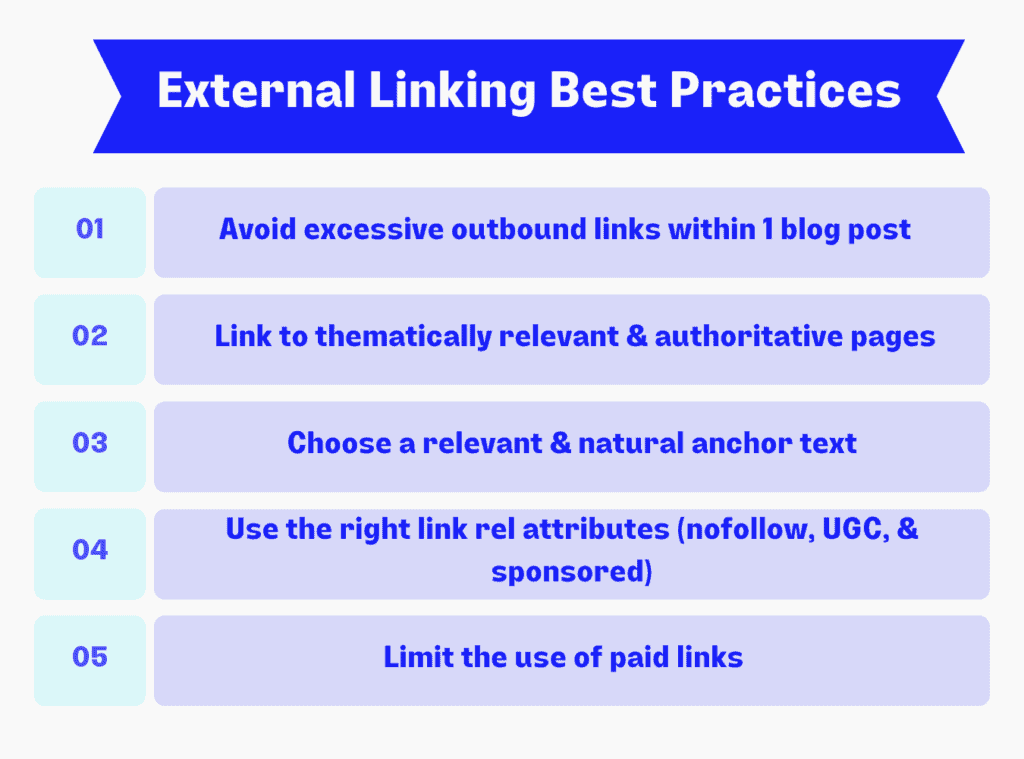
However, external links can’t just be random like a blog written by someone without any expertise on the topic. Make sure the site you’re linking to is reputable and that the content is relevant to your topic.
For instance, if you have a blog post about organic skincare, it’ll be helpful to link to a scientific study that validates the benefits of organic ingredients. It fortifies your content’s authority and shows you’ve done your homework.
Also, have your external links open in a new tab. This increases time on site, reducing the bounce rate and retaining user engagement.
7. What should I consider in creating media-rich content?
When you click on a website and land on a webpage full of dense text, it can be overwhelming.
But let’s say you land on a fitness blog with a mix of text, workout videos, and diet infographics. The content feels more digestible and engaging. The goal is to enrich your content, not just to decorate it.
So relevance is critical. If you’re writing about solar panels, a video demonstrating how they work or what benefits they have adds value.
Moreover, don’t overlook the mobile-friendliness aspect. With the rise in mobile browsing, you want your media to render well on smaller screens too. You don’t want your readers to scroll from side to side just to see the full picture.
8. What elements should my image alt text include?

Frontload your primary search term and add a very brief description of what the image is about. This helps search engines index and understand your images.
Alt text also improves accessibility for users with visual impairments. For example, let’s say you have an infographic of content optimization techniques on your site. A good alt text can be “5 key content optimization techniques.” If your primary search term is “Best SEO practices,” you might adjust it to “Best SEO Practices – 5 key content optimization techniques.”
9. Are my web pages thin or obsolete?
During your SEO audits, scrutinize every corner of your enterprise website. You might stumble on pages thin on content or perhaps have passed their expiration date.
How do you spot them?
If a page provides little value to users or is no longer relevant, it needs attention. Here’s how you know you’re not offering value:
- A search term-stuffed blog post.
- Only summarizing points from other articles.
- Your article does not demonstrate expertise.
- Discussing trending topics that aren’t related to your niche.
Update outdated information with fresh, relevant content. If a page is light on substance, don’t just fluff it up – add valuable insights that your users can apply.
However, if a page can’t be salvaged anymore, remove them. Keep in mind, search engines favor quality over quantity.
10. Do I check for duplicate content?
Duplicate content is easy to overlook when you’re handling thousands of pages. So, why do you even need to think about this among your tasks, right?
Well, duplicate content can bewilder search engines, causing them to split the traffic between versions and hurt your organic search rankings.
But don’t worry, there are tools to prevent this.
- Siteliner: This scans your entire website for duplicate content. It generates a report, highlighting the pages that contain duplicate content and shows you the match percentage, and pinpoints the duplicated text.
- Copyscape: Enter your page URL to compare your content with everything else on the web. If it finds matches, it’ll alert you with a detailed report showing the percentage of similarity and the sources.
So what happens when you find duplicate content?
Review those pages and decide which one serves your users best. Then, either modify or remove the other.
Off-Page Enterprise SEO Audit Points
This focuses on boosting your site’s reputation and visibility. From inbound links from other sites to guest posting, off-page SEO actions help enhance your site’s trustworthiness, authority, and credibility.
11. How do I earn more relevant backlinks than my competitors?
A significant part of your enterprise SEO strategy involves securing high-quality, relevant backlinks.
Do a website backlink analysis using Ahrefs, Google Analytics 4, or Moz. These tools provide valuable backlink profile information, revealing the websites linked to your site.
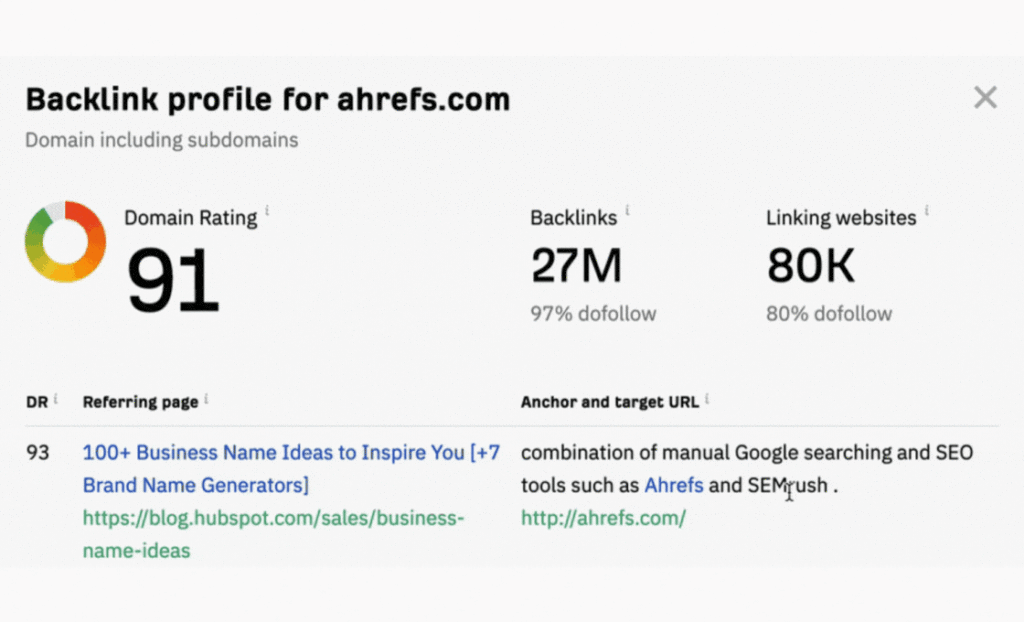
Using the auditing tool of your choice, you can enter your competitor’s domain to run a backlink analysis of their website. You’ll have a list of all those backlinks boosting your competitor’s site and the ins and outs of the page referring to them.
12. What should I do to keep my content free from toxic backlinks?
You don’t want those party crashers to damage your website’s reputation, earning you a stern look from search engines and users. So make removing them part of your regular enterprise SEO audits.
Now, here’s where tools come into play. With Google’s Disavow Tool or SEMRush’s Backlink Audit Tool, you can sift through your backlink crowd and spot any mischief-makers. They’re usually from spammy sites or low-quality forums.
How do you remove them?
Ask the webmaster to remove your links from their site. However, if they don’t answer you back, you can have Google do the work. You can filter domain referrals, so Google turns a blind eye to rogue links.
13. Do I distribute anchor text equally throughout the article?
Over-optimizing your anchor text and using the same term repeatedly leaves a spammy aftertaste in search engine palates. The key is to strike a balance between making your anchor text informative and maintaining a natural flow within your article.
Here’s how you can do that:
- Maintain a natural distribution: Distribute your anchor text throughout the article evenly and organically. Don’t force search terms where they don’t fit naturally.
- Use descriptive and keyword-rich anchor text: This helps both users and search engines understand what the linked page is about.
For instance, in an article discussing the importance of external and internal links, you might use anchor text like, “External links are crucial for building authority” and “Learn how internal linking can improve your web page’s visibility.”
14. Do I vary and use descriptive anchor texts?
Do this to avoid repetition and confusing the search engine and users.
For the former, their deployed bots depend on anchor texts to inform their understanding of your site’s architecture and the relationship between various pages, helping them to index your site accurately.
For your site visitors, varied anchor texts tell them what to expect when they click on a link, enhancing the user experience and potentially boosting your click-through rates.
15. How do I guest post on high authority sites?
Guest posting on high-authority sites will help you build backlinks, gain exposure to a larger audience, improve your website’s credibility, and boost your online visibility.
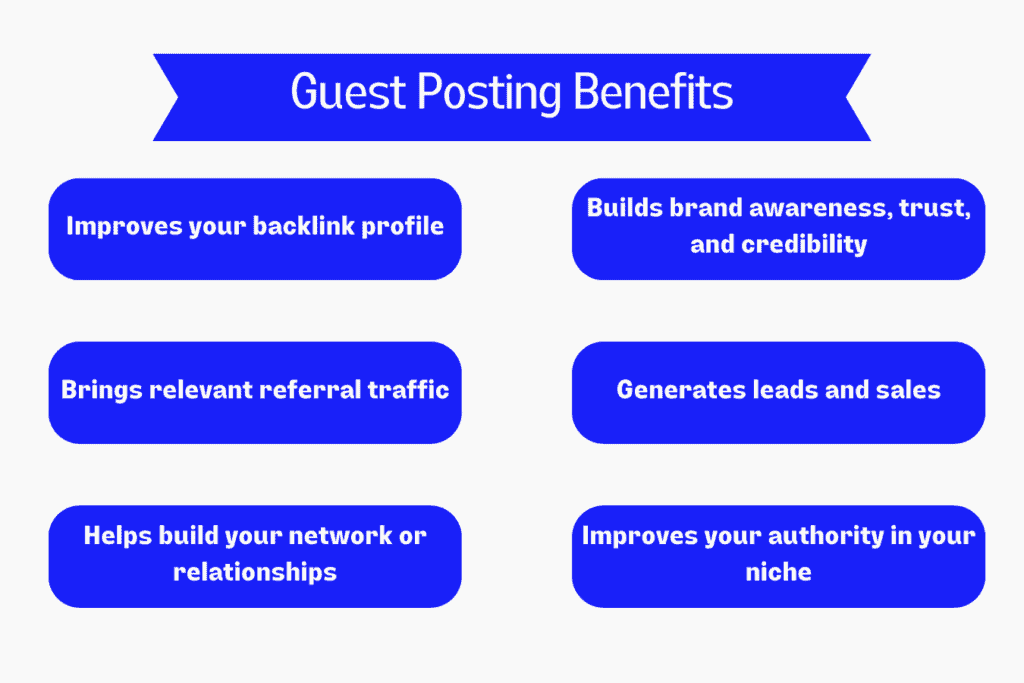
To do this, ask ChatGPT4 to give you a list of search terms related to your niche. Then, go to Ahrefs’ “Content Explorer” tab and paste the search term you want the platform to analyze.
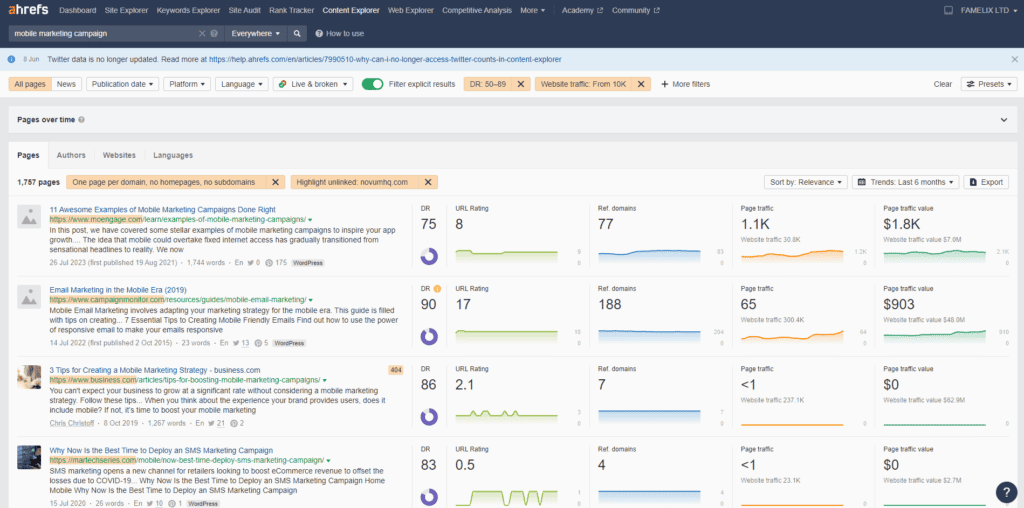
You can then export and merge the CSV files to get the domains of the top-ranking sites for that search term.
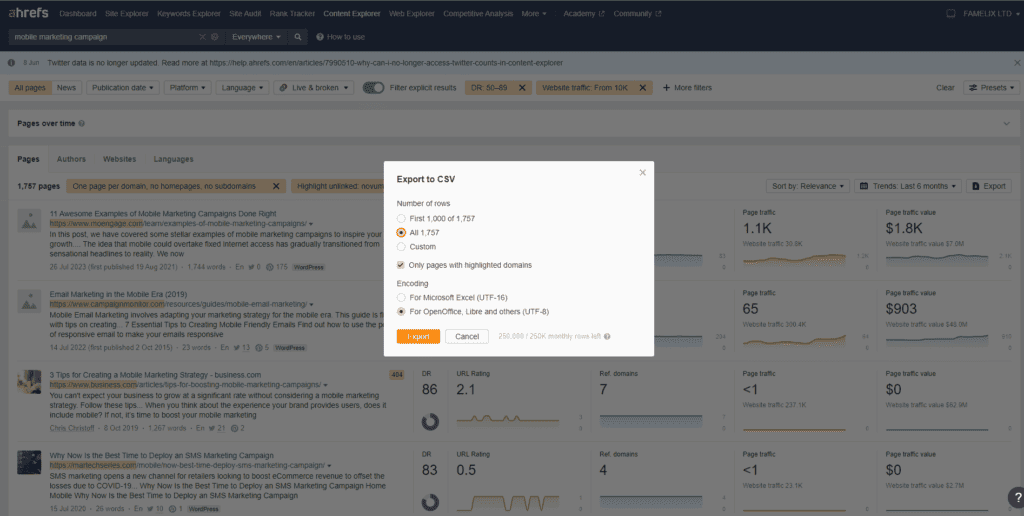
You’ll need to vet the domains so you end up with a list of leads that matches your criteria. Then, leverage LinkedIn Sales Navigator to gather the contact information of relevant employees, such as SEO specialists or content marketing specialists.
You can use an outreach tool like Smartlead.ai to send emails and reach your prospects. Once they agree with a guest post and the topic you’ll write, it’s time to craft a captivating piece. Remember, your article needs to be a fit not only for the site but also for its audience.
Think about what these readers want, need, and love. Here’s the cherry on top: include a link back to your enterprise website in your author bio or within the article, adhering to the host site’s guidelines.
Technical Enterprise SEO Audit Points
A technical SEO audit is all about making sure your website gets easily crawled and indexed. From fixing broken links to optimizing page speed, it covers the nitty-gritty that makes your website well-oiled, fast, and error-free.
16. Should I submit an XML sitemap?
Creating an XML sitemap and submitting it to Google is like handing over the keys to your enterprise website to the search engines. This crucial file lists all your web pages and helps search engines discover and index your content faster.
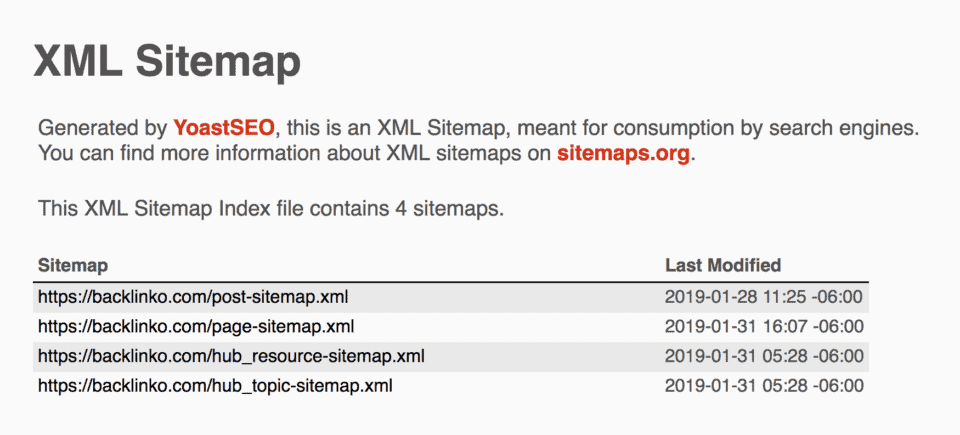
How do you whip up this roadmap? It doesn’t have to be a complex task, especially with SEO tools. For instance, Screaming Frog’s SEO Spider tool crawls your website and automatically generates an XML sitemap, listing all your pages and associated metadata.
Then, you’ll need to go to your Google Search Console account to submit the XML sitemap. You can either submit it using the Sitemaps Report or through the Search Console API.
17. Should I max out my crawl budget?
Maxing out the crawl budget for your enterprise site shouldn’t be your primary concern. Instead, focus on how not to waste your current crawl budget, so it’s not misspent on irrelevant pages.
Google allocates your crawl budgets based on the authority, relevance, and overall performance of your website. So, how do you do that?
First, spruce up your site architecture and make sure it’s easy to navigate, with your most critical pages only a few clicks away from the home page. Second, keep an eagle eye out for duplicate content and broken links.
Finally, make sure your pages are Usain Bolt-fast. Slow pages are a turn-off, both for search engine bots and users. If your server loads faster, it responds to Google’s request to crawl faster.
18. What tool should I use to do my schema markup properly?
Schema markup, also known as structured data, helps search engine bots decode your content more effectively.
How do you do this? Google’s Structured Data Markup Helper.
This tool guides you through adding schema markup, making your content more understandable and SEO-friendly. Focus on doing this to your key pages or the content you want to boost.
Then run that page through Google’s Rich Results Test to verify if everything is implemented correctly.
19. How do I fix broken links or redirects?
Having these links is like inviting someone over and not being home. That’s how your website visitors will feel when they encounter broken links or misbehaving redirects on your site.
It also confuses search engine crawlers, causing your site to lose traffic and fall in rankings.
To fix this, use Screaming Frog and Ahrefs to act as your website’s doctor. They have features to let you spot broken links or improper redirects so you can fix these issues more seamlessly.
For example, in Screaming Frog, this is all you need to do:
Paste the URL then click start > Select the “Response Codes” and click “Client Error (4xx)” to see your broken links.
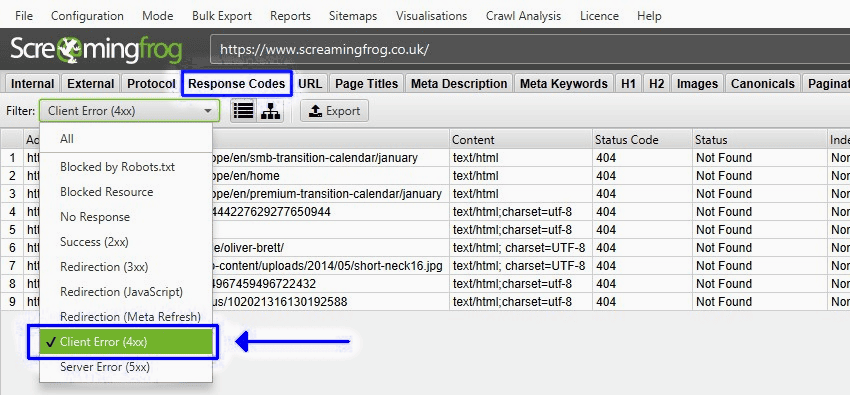
Then, select the Inlinks Tab to view the source of the broken links:

In addition, you can use 301 redirects. This is a status code that signals a redirect from one URL to another. It’s like saying, “Sorry, we’ve moved, but here’s where you can find us.”
This guides your site visitors and search engines from outdated pages to relevant ones, ensuring a smooth experience while preserving your link juice.
20. Should I include canonical tags?
These tags guide search engines to the ‘master’ version of the content, eliminating confusion over duplicate pages.
This is commonly utilized in enterprise eCommerce websites when they have comparable products listed but with a focus on specific regions. Adding a canonical tag to the main product page, you’re telling search engines: “This is the official page; focus on this one.”
To do this, add a link element with the attribute rel=”canonical” to the <head> section of the non-canonical pages, pointing to the URL of your chosen canonical page. You’re going to need your enterprise and IT teams to work on this because it involves editing your HTML.
21. Do I need hreflang tags for multilingual content?
These hreflang tags are codes to inform search engines which language is used on a specific web page ensuring that the right content reaches the right audience.
Here are some examples:
- France: <link rel=”alternate” hreflang=”fr-FR” href=”http://example.com/fr/” />
This tag tells search engines that the page is designed for French-language speakers in France.
- Spain: <link rel=”alternate” hreflang=”es-ES” href=”http://example.com/es/” />
This tag tells search engines that the page is designed for Spanish-language speakers in Spain.
For a large website with multiple languages or regional versions, managing hreflang tags could be challenging. However, employing the right enterprise SEO services and harmonious collaboration between the involved stakeholders (IT & SEO) can make the process more manageable.
22. How do I keep up with algorithm changes?
Google’s algorithm changes can swing your enterprise website’s rankings – for better or worse. Given the scale and complexity of enterprise sites, these shifts can have significant impacts.
How do you keep up? Information is your greatest ally here, and Google provides plenty of those. It has the “The Keyword” blog, Google Search Central, and YouTube videos. Additionally, you can use secondary resources like Search Engine Journal.
They offer invaluable insights into the latest changes and how they impact search engine optimization strategies.
But you and your knowledge can only do so much. Ultimately, the biggest responsibility falls on your SEO team and their regular SEO audits. These audits help identify areas where your site might fall short of the latest best practices.
Leveraging Google Analytics can help with this process. It provides detailed data on your site’s performance, letting you fine-tune your SEO strategy accordingly.
User Experience Enterprise SEO Audit Points
This affects how visitors interact with your site and can directly influence organic traffic. When your site is easy to navigate, fast, and provides valuable content, users stick around. This sends positive signals to search engines, helping boost your position in the rankings.
23. Are Google’s Core Web Vitals standards essential?
Meeting Google’s Core Web Vitals standards measures key aspects of your site’s user experience, specifically focusing on loading performance, interactivity, and visual stability.
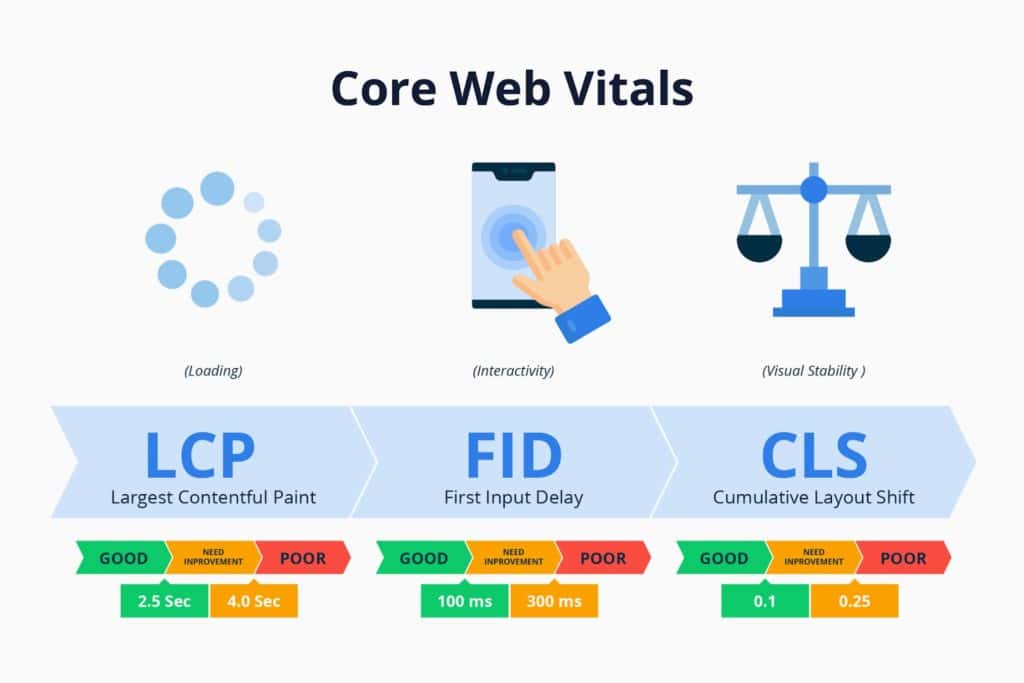
Why is this important for your SEO? Because Google takes user experience seriously when determining which websites to show in SERPs.
Now, here’s where teamwork steps into the limelight.
Your IT team should make sure your site has a strong technical backbone for fast page loads and stability. The UX/UI team designs an interactive, visually appealing experience on mobile devices or desktops. Meanwhile, your SEO team stays on top of these metrics, making data-informed suggestions for improvement.
24. Is SSL the way to secure my website?
An SSL (Secure Sockets Layer) certificate is the internet’s standard for safeguarding information exchanged between your website and its users. It encrypts the data, reinforcing the security.
This is crucial when you’re managing a website with thousands of pages since the vastness and complexity of managing them can potentially expose more vulnerabilities.
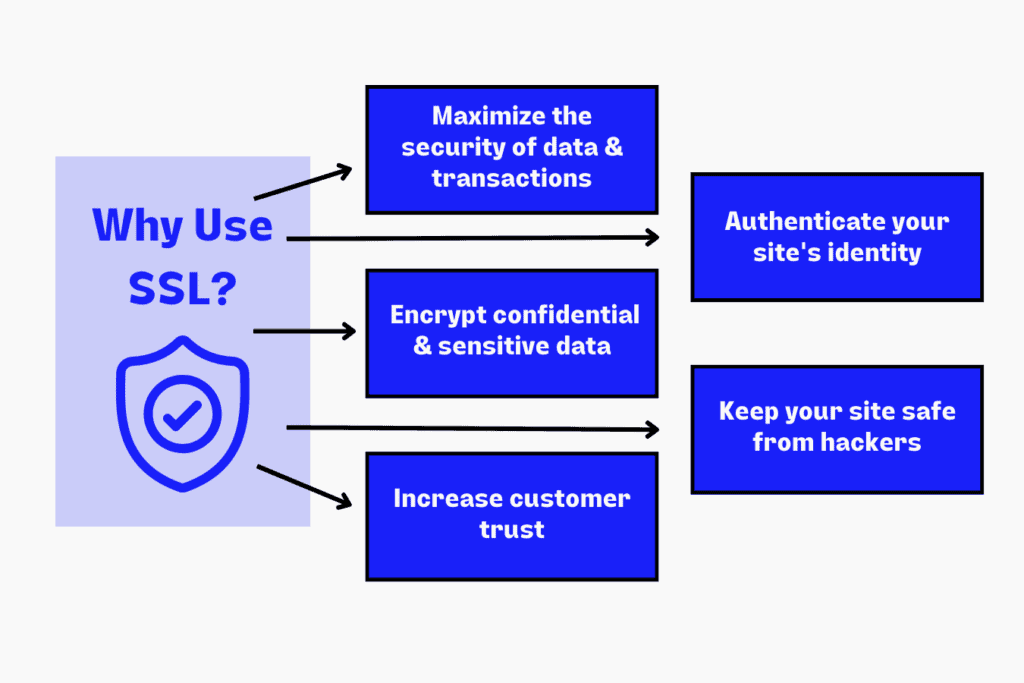
Moreover, Google deems sites without SSL as “not secure.” This warning is visibly slapped on your URL, discouraging potential visitors.
So, getting an SSL certificate helps you put on a strong front, warding off security threats and signaling visitors that their information is safe with you.
25. Is my website accessible to all users?
Accessibility makes your website user-friendly for everyone, including those with disabilities.
It entails features like appropriate color contrast for easy viewing, sizable text for better legibility, image alt tags for screen readers, and keyboard navigation for those unable to use a mouse.
Additionally, accessibility doesn’t stop at desktops; it extends to mobile devices too. Mobile-friendliness is a crucial Google ranking factor for a seamless user experience.
It also enhances user engagement and conversions, as users are more likely to interact with and purchase from your site if it’s easily navigable on their device.
26. Is simplifying my site architecture a must?
Think of your site as a department store. Customers shouldn’t have to wander through endless aisles to find what they need. Important pages should be just a few clicks away from the homepage – just like how the popular items are always front and center in a store.
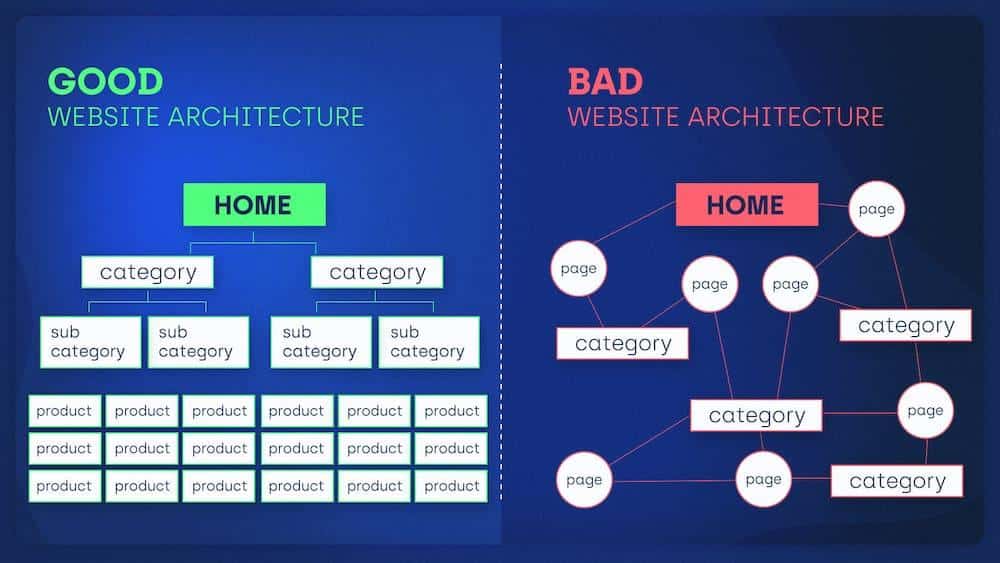
Your site users want information and they want it fast. A clear and intuitive site architecture helps them navigate to their desired content without getting lost or frustrated.
This will involve a comprehensive enterprise SEO audit that requires meticulously analyzing data to spot and rectify any potential pain points in navigation. Use tools like Hotjar, CleverTap, and FullStory to see how users interact with your site, so you can identify any hiccups in navigation.
Industry Enterprise SEO Audit Points
Analyzing industry trends and competitors lets you tailor your enterprise SEO strategy and optimize your website accordingly.
27. What factors do I consider to show high levels of E-E-A-T?
Your website should radiate experience, expertise, authoritativeness, and trustworthiness (E-E-A-T) – key component search engines use to judge your content. This is especially vital for YMYL (Your Money or Your Life) websites dealing with critical subjects like health and finance, where misinformation has severe impacts.
So, how do you achieve E-E-A-T?
- Experience: Your content should show a depth of knowledge that’s consistent with your experience.
- Expertise: Your content creator should demonstrate expertise through academic credentials or references from other experts. So if you have a blog with medical advice, it should be created by qualified health professionals.
- Authoritativeness: This refers to the credibility and reputation of your website, as well as the content creator in your niche. The quality of the content, credentials of the author, and external references or links to the website influence this.
- Trustworthiness: Factors like website security, transparency about who is behind your website, and the presence of accurate and verifiable information contribute to your site’s trustworthiness.
Now that you’re all set up with the 27-point enterprise SEO checklist, let’s consider the tools you can use to help you with your audit.
3 Must-Use SEO Audit Tools To Master
With the scale and complexity of enterprise websites, manual checks aren’t enough. So to conduct enterprise SEO audits, you’ll need a robust arsenal of SEO tools.
They’ll help you sift through thousands of web pages, identify technical issues, assess on-page SEO elements, and measure overall site performance. Thus, simplifying your enterprise-level SEO audit, and making it quicker, more efficient, and most importantly, more accurate.
A. ChatGPT4
This powerful language model excels in producing human-like text, aiding you in many aspects of your SEO strategy like content optimization. It can craft SEO-friendly content with relevant search terms from your niche or specific topic.
Additionally, it can help you with technical SEO. ChatGPT4 can generate codes and hreflang tags, giving you a headstart even if you’re not a tech wizard.
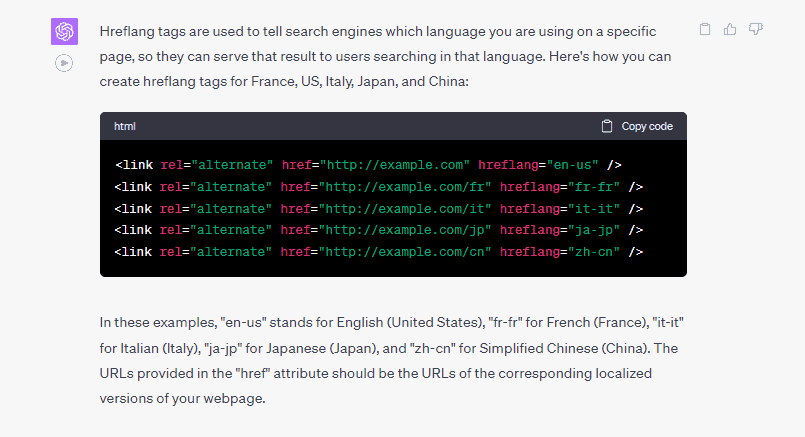
It also supports plugins to enhance functionality and customizability. With them, ChatGPT4 can fetch real-time data from the internet, interact with APIs, and more.
This plugin feature expands the capabilities of the platforms, allowing you to automate more tasks. With your website’s vastness, this can streamline your enterprise SEO audit and optimization, saving you time and other resources.
B. Google Search Console (GSC)
When you look at it, Google Search Console data is a goldmine providing an array of useful insights into how Google’s search engine interacts with your website, helping you pinpoint areas of improvement.
For starters, GSC offers critical data on your site’s performance in search results. Under the performance reports, you can see the following:
- Clicks
- Impressions
- Average Click-Through-Rate (CTR)
This data can guide your strategy, showing you where to double down and where there’s room to grow. Plus, GSC also provides data on your site’s coverage in Google’s index.
The Page Indexing Report will show you which pages have been indexed and which haven’t and why specific URLs weren’t indexed. This is particularly useful for large enterprise websites with thousands of pages, making sure none get lost in the shuffle.
C. SurferSEO
The size and complexity of enterprise websites demand efficient, data-driven analysis, which is precisely where SurferSEO excels. One standout feature for enterprise-level audits is SurferSEO’s SERP Analyzer.
It breaks down the on-page elements of top-ranking pages for any given search term, offering insights on word count, search term usage, and more. This is an invaluable feature considering you’re managing multiple search terms across hundreds to millions of pages.
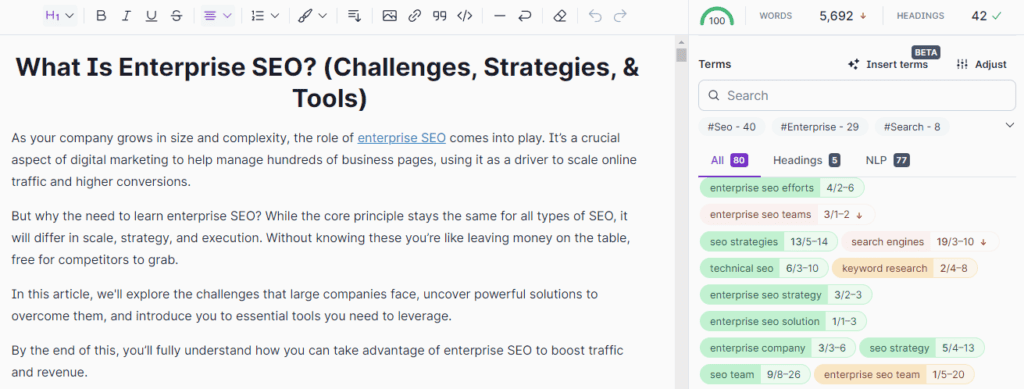
Additionally, SurferSEO’s Content Editor feature lets you audit content on a large scale. It factors in search term density, related phrases, and overall content structure. Plus, it’s flexible, so you can customize the elements if you want to add search terms or remove some.
But let’s go further than just providing you with tools. Let’s talk about how we took a client’s dwindling organic traffic and turned it around, boosting numbers through a strategic SEO overhaul.
Aloa Case Study: A Successful Enterprise SEO Audit In Action
Aloa is a cutting-edge platform providing resourceful, reliable, and effective outsourcing solutions for businesses. They connect clients with top-tier freelancers and agencies globally for services like app development and web design.
They take pride in building their proprietary tools and processes to achieve quality and efficiency. This complements their mission to revolutionize software outsourcing.
I. The Problem
- Had no solid SEO game plan.
- Sign-up rates and MRR needs boosting.
- Only produced content from guest authors and collaborations.
- Budget wasted from ad costs that didn’t produce sufficient results.
- Marketing team was smaller compared to competitors like Freelancer and Upwork.
II. The Solution
- Create a holistic SEO and content strategy.
- Collaborate with the other stakeholders (product development and marketing teams).
2.1. SEO-Driven Content Strategy
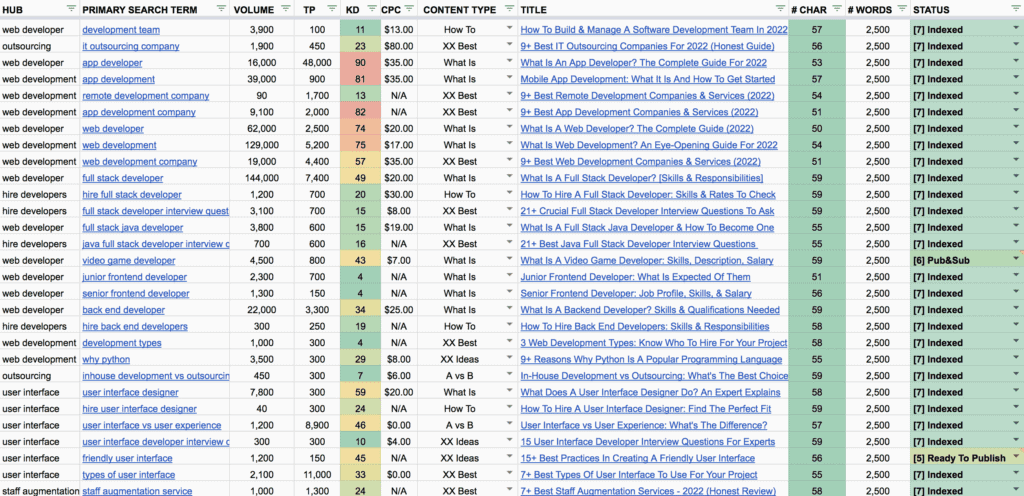
Aloa had a content section, but many posts weren’t structured to attract leads or customers so it had little business value.
Here’s what we did:
- Examined search intent.
- Analyzed competitor gaps.
- Conducted a holistic search term deconstruction.
- Created an ROI-driven and data-driven content strategy.
Through that, we focused on driving relevant traffic to boost conversions and turn site visitors into valuable leads and paying customers.
2.2. A+ Content

We upgraded Aloa’s existing content to A+ status for optimal relevance from Google’s perspective, making it more likely to rise through rankings.
For the new content, we did the following:
- Employed the hub and spoke method.
- Increased the semantic relevance for high-performing, competitive transactional “hub” search terms.
- Built more in-depth content using less competitive informational “spoke” queries.
2.3. Strategic Digital PR
Aloa, being a new domain, required a vigorous digital PR strategy to publicize its fresh content and enhance domain equity.
Here’s what we did:
- Determined Aloa’s most beneficial pages – those that attract sign-ups and new customers.
- Capitalized on our pre-existing connections with publishers and influencers in the software and business sectors.
- Constructed precise in-content links from renowned, highly authoritative websites directly to these valuable assets.
III. Results & Improvements
Within 16 months, Aloa’s organic search visits grew by 442%.
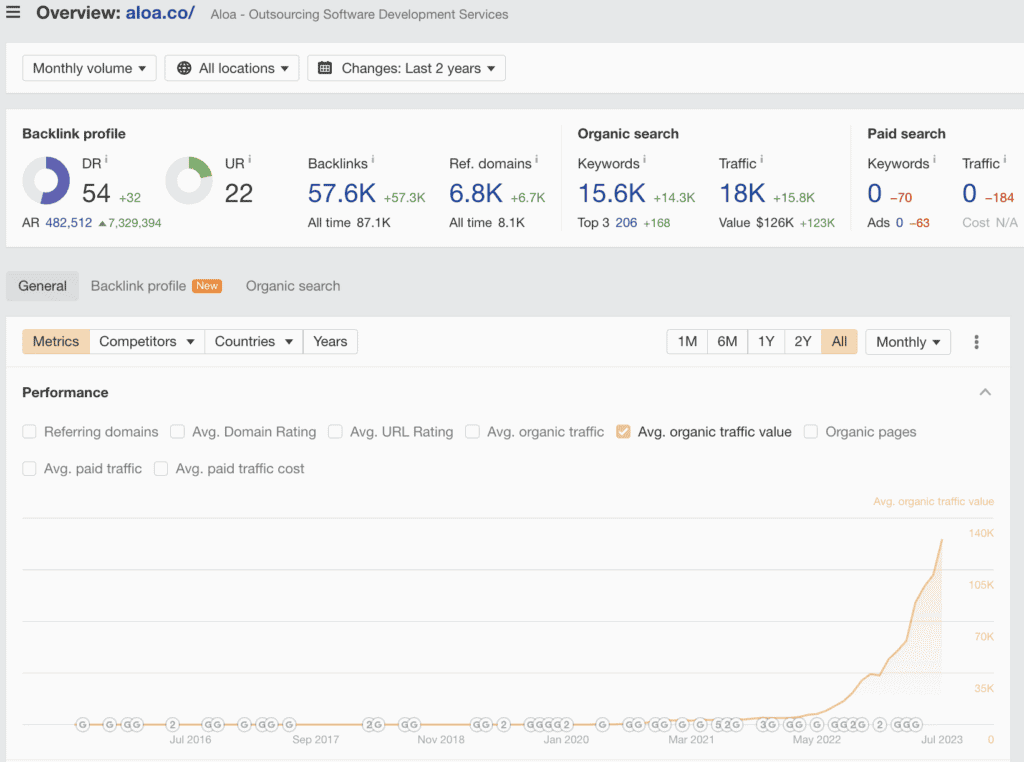
Other results include:
- 2,330% traffic growth
- 32,516 search terms indexed
- 318% rise in monthly sign-ups
- $1,514,376 annual traffic value
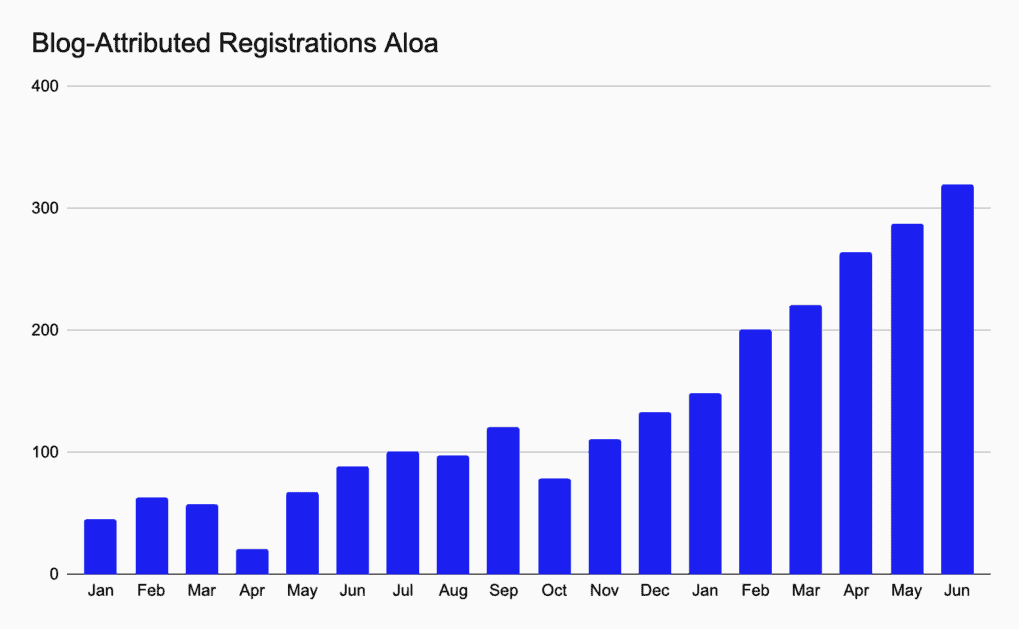
How You Can Get Started
A thorough enterprise SEO audit is daunting, considering the number of web pages you’re managing. But this 27-point enterprise SEO audit checklist can get you started, ease your process, and lessen the burden on you and your team.
Conducting the audit helps in uncovering hidden opportunities and identifying potential pitfalls, enabling you to adjust your enterprise SEO action plan for maximum impact. With this categorized checklist, you’re setting the stage for improved visibility, increased traffic, higher conversions, and ultimately, more paying clients.
However, an enterprise SEO audit is a continuous process that’ll require resources and years of expertise to maintain your website’s good shape. Thus, you need a partner-in-crime that has a proven track record (the good kind).
So are you ready to get to work?
We’ll give you a strong hand to get you a jumpstart and develop an enterprise SEO strategy aligning with your business goals. With our ROI-driven approach and expertise, we’ll give your site the treatment that’ll boost your organic visits and traffic value.
Let’s start talking and schedule a consultation now so we can build your roadmap.
FAQs
How much does an enterprise SEO audit cost?
The cost of enterprise SEO and an audit can vary greatly depending on the size and complexity of the website, the industry, and the specific business needs.
However, enterprise SEO’s average pricing is between $5,000 to $25,000 per month.
How often should you run an enterprise SEO audit?
It depends on factors like the website size, the industry you’re in, the level of competition, and the changes you make.
Although, a popular interval for an in-depth audit is 2x a year or every 6 months, if you apply significant changes in between, make sure you do an additional SEO audit.
How does an “enterprise SEO audit” differ from a “regular SEO audit”?
An “enterprise SEO audit” and a “regular SEO audit” share the same fundamental goal: To identify areas for improvement in a website’s search engine optimization.
However, the scale, complexity, organizational management, and resource allocation differ significantly.
An enterprise SEO audit requires a more sophisticated approach because of the complexity of the site architecture, the volume of content, and the intricate internal linking structures. Plus, they often involve analyzing multiple international markets, languages, and extensive search term portfolios.
In contrast, a regular SEO audit is usually performed on smaller websites. While it covers similar areas – such as on-page SEO, off-page SEO, and technical SEO – the scope and depth of the audit are generally less intensive.

